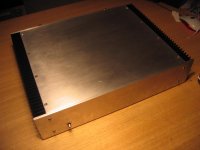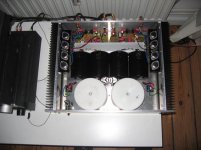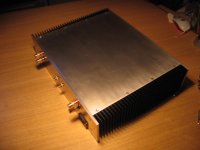acenovelty said:Are there any practical suggestions for a solution for joe mobile's
stated question?
I thought I offered a couple of reasonable suggestions for seeing if the bias circuit is functioning in post # 18.
Regards Mike.
joe mobile said:I just blew the amp by accidently shortening R36 so for now my problem is solved... I`ll start a new leach amp. I guess thats learning the hard way.
Joe
Joe,
I guess the my last post is not needed now. To bad, troubleshooting is where we learn the most..
Just out of curiousity, why is is necessary to build a new amp from scratch? I've blown up more amps than I'd care to admit to, but I've always just troubleshot the damage and got it running again, if only to make myself feel less stupid about whatever dumb-#&% mistake I made. I'm assuming the boards are in rough shape getting it to this point in the game.
Oh well, it's always nice when the current project is listenable.
Regards, Mike
Unlike other commentaries, you did indeed MikeBettinger. Others seem more interested in esoteric semantic discussions. Our friend from Hamburg asked for help and got a doctorial sounding lecture from some admittedly very clever folks.
And then he presents his own solution. However, a burned 220 ohm R36 resistor adds a certain difference to the problem than that first stated.
As for me , I only know what Prof. Leach says about his creation. Uncommonly good practical advice in my experience.
And then he presents his own solution. However, a burned 220 ohm R36 resistor adds a certain difference to the problem than that first stated.
As for me , I only know what Prof. Leach says about his creation. Uncommonly good practical advice in my experience.
R36 - 220 ohm - If you have a problem with the VBE multiplier or the bias diodes, the bias voltage can go too high and this resistor can smoke and possibly burn the circuit board. I recommend putting a 1/8 inch long piece of insulation stripped from a piece of hookup wire on each lead of this resistor before soldering it to the circuit board. The insulation will hold the resistor up off the circuit board in case it burns. If you wish, you can use a 1/2 watt resistor for R36.
acenovelty said:Unlike other commentaries, you did indeed MikeBettinger. Others seem more interested in esoteric semantic discussions. Our friend from Hamburg asked for help and got a doctorial sounding lecture from some admittedly very clever folks.
And then he presents his own solution. However, a burned 220 ohm R36 resistor adds a certain difference to the problem than that first stated.
As for me , I only know what Prof. Leach says about his creation. Uncommonly good practical advice in my experience.
hi ace,
indeed, a very practical advice from prof. leach...i've seen japanese commercial amps even used ceramic beads(tubes if you will) to serve as standoffs for resistors that are liable to burn when something goes wrong.
The discussion was good and actually got me thinking on a different plane about my own approach which, with time, I believe will be beneficial.acenovelty said:Others seem more interested in esoteric semantic discussions.
As for me , I only know what Prof. Leach says about his creation. Uncommonly good practical advice in my experience.
Although, I couldn't help thinking that the discussion was, as you say, a semantic difference.
The Professor using a diode string for temperature sensing and calling it a Vbe multiplier. The intent being to keep the discussion of the circuit in a normal frame work (my interpertation). While technically he's not using the transistor junction as the sensing mechanism, which would be the correct implementation of the terminology.
Good discussion though. Although, I'm not so sure the improved circuit posted by Mike K will actually pan out as sonically any better than my current simpler approach.
My thoughts, since I haven't been able to build anything, tells me that a bias shift could be responsible for the difference I hear between lower and higher listening levels. (the problem is definitely in the output stage)
With my current interpertation of the posted circuit, with no component values or operational discription, I'm assuming:
Transistor one to be the sensing junction.
Transistor two provides a mild amount of gain to increase the sensitivity and more or less isolate the junction from the effects of the current through the circuit block.
Transistor three being the pass transistor (so to speak) to develop the bias voltage across and present a low impedance to the output stage. Like I said I've only been pondering this.
My reservations are based on using three junctions in series with a noise generator as an input to create a stable voltage reference. Kinda like using a sledge hammer to put in a finishing nail. Especially if, with my three 1N4148s touching the heatsink, the amount of change in current through the diodes does not produce a major shift in bias in normal operation. A few test and I'll have my answers.
Has anyone already been down this path? Is my loose description of the circuit operation fatally flawed?
Regards, Mike.
No,
the multiplier function is determined by the ratio of the upper and lower resistors. And is adjusted in exactly the same way.
The diode string adds an offset to the multiplied Vbe.
With the offset only a small multiplication ratio (of about two times) is required to arrive at a suitable output voltage, rather than the five times or so that comes from a resistive multiplier without the added offset.
Leach has arranged for the temperature compensation to be applied to the diode offset rather than the transistor and he explained why he chose this route, even if his logic is correct or flawed.
the multiplier function is determined by the ratio of the upper and lower resistors. And is adjusted in exactly the same way.
The diode string adds an offset to the multiplied Vbe.
With the offset only a small multiplication ratio (of about two times) is required to arrive at a suitable output voltage, rather than the five times or so that comes from a resistive multiplier without the added offset.
Leach has arranged for the temperature compensation to be applied to the diode offset rather than the transistor and he explained why he chose this route, even if his logic is correct or flawed.
With all respect to the lawyers arguing over the meaning of words, the original post seemed to be asking for help figuring out why his amp was not responding to his attempts to set the bias.
FWIW Joe, If you haven't been successful getting the amp to react properly, my guesses are:
1. Solder bridge remaining after you removed the jumper for testing.
2. incorrect/reversed transistor in the Vbe multiplier (or whatever you choose to call it.)
If you have been successful, please post what you found so we can add to the collective "mistakes that have already been made" database.
FWIW Joe, If you haven't been successful getting the amp to react properly, my guesses are:
1. Solder bridge remaining after you removed the jumper for testing.
2. incorrect/reversed transistor in the Vbe multiplier (or whatever you choose to call it.)
If you have been successful, please post what you found so we can add to the collective "mistakes that have already been made" database.
Thanks Bob, I already checked that, the jumper was removed. The transistor was the right type, mounted correctly. Maybe the transistor was just broken, but it`s too late to check that, because I blew the amp... all I can say that now T7 is broken.
When I blew R36 the driver transistors were blown. I replaced them, but after that I had 60 V DC on the output. So there are other things broken too.
I will rebuild the amp now, and I hope that this time the bias- setting will work correctly ( and everything else too ).
I also want to thank acenovelty for reminding everybody of my original question. Thank you. Still I think it`s nice when the discussion just goes on in some direction. I`m not sad about that.
Nice forum here, I already spent hours reading.
good night or nice day to everyone,
joe
When I blew R36 the driver transistors were blown. I replaced them, but after that I had 60 V DC on the output. So there are other things broken too.
I will rebuild the amp now, and I hope that this time the bias- setting will work correctly ( and everything else too ).
I also want to thank acenovelty for reminding everybody of my original question. Thank you. Still I think it`s nice when the discussion just goes on in some direction. I`m not sad about that.
Nice forum here, I already spent hours reading.
good night or nice day to everyone,
joe
to mike
thank you too, you indeed gave me some tips, but I have to admit I`m not far enough with electronics to understand all you proposed... but I read it and I`m learning.
I want to rebuild it, because I think there must be quite a lot broken. Someone gave me the tip to replace every diode and transistor, so why not build a new one. But I`m still measuring on the broken amp to see wich parts are broken.
joe
thank you too, you indeed gave me some tips, but I have to admit I`m not far enough with electronics to understand all you proposed... but I read it and I`m learning.
I want to rebuild it, because I think there must be quite a lot broken. Someone gave me the tip to replace every diode and transistor, so why not build a new one. But I`m still measuring on the broken amp to see wich parts are broken.
joe
joe mobile said:I`m not far enough with electronics to understand all you proposed... but I read it and I`m learning.
I want to rebuild it, because I think there must be quite a lot broken. Someone gave me the tip to replace every diode and transistor, so why not build a new one. But I`m still measuring on the broken amp to see wich parts are broken.
joe
Joe, Once you get to the bottom of what blew up and the amp is working my suggestions were actually pretty straight forward checks you could make. Unfortunately it's easy to assume that everyone has the same level of understanding and one can tend to get lost in the terminology.
If you have 60 volts on the output it's pretty clear that something is still blown. I'm not looking at your schematic (so I'm not sure what the resistor you shorted out does) but a few minutes spent looking at the place in the schematic that you shorted might draw power from and where the short might have sent power through. This can help you to narrow done where to look for bad parts. You don't need to swap everything out.
From what clues you've supplied I'd assume that you were checking something in the bias circuit or trying to measure the bias on the outputs. If it was the bias circuit then I'd be checking the voltage amp transistors that feed it. If drivers are blown, the outputs are gone as well, even if they don't read shorted (they might have opened up internally from the overload.
Troubleshooting is like a game where you look at the clues and try to figure out what they mean. It's a good way of reconciling your knowledge with the real world.
Send me a link to the schematic your working with and I can be of some help. Also when troubleshooting it helps to wire a 60 watt light bulb in series with the AC to the amp. If you make a mistake the bulb just glows brightly and you don't blow-up a bunch of parts. Do take the time and spend a couple of euros to build a solid/ safe assembly for doing this. You don't want a hotwired power connection on your workbench. You'll need a light socket, outlet box, outlet and power cord. I can draw up a wiring diagram if you're unsure of what I'm describing. You defintely want to be safe when it comes to messing with the AC power.
Good luck troubleshooting. Regards, Mike.
- Status
- This old topic is closed. If you want to reopen this topic, contact a moderator using the "Report Post" button.
- Home
- Amplifiers
- Solid State
- leach amp vbe multiplier


